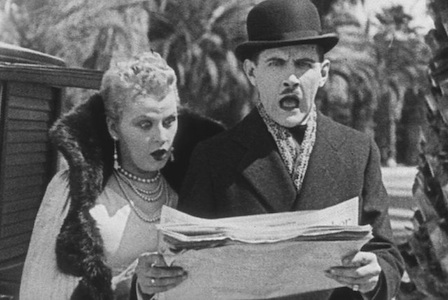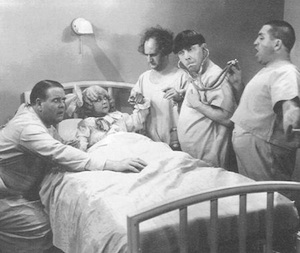
During his short but rather astonishing life (he died of a heart attack in 1955, at age 45), the critic, novelist, scenarist and journalist James Agee wrote a 1949 feature for the hugely popular Life magazine. Called “Comedy’s Greatest Era,” it paid loving homage to the clowns of silent cinema, a medium that had given up the ghost just two decades earlier but already seemed as remote as the days of dinosaurs to most moviegoers. Revival screeners were then very rare. TV hadn’t yet created a market for the studios’ back catalogs. And preservation efforts were nil.
What Agee’s article did was commence a great groundswell of new interest in old comedy that would stretch well into the 1960s—when compilation features spawned by 1957’s The Golden Age of Comedy continued to thrive—and in fact would never really go away. (As evidenced most recently by The Artist.) Further, it created an official canon that, for better or worse, would define the pecking order of silent comedians for generations to come.
Agee wrote primarily about four silent kings of comedy: Charlie Chaplin, Buster Keaton, Harold Lloyd, and Harry Langdon. (If the last incongruously doesn’t ring a bell, no wonder: That baby-faced, childish-acting clown sabotaged his own career at the height of fame by insisting on directing himself, to disastrous results. More contemporary audiences have never warmed to his persona as mid-1920s ones briefly did.) Beyond obvious talent, these choices had something in common: They’d all successfully transitioned from shorts to the features from which they’d remain best known. By the time Agee wrote his essay, cartoons and newsreels were still a regular part of the filmgoing experience, but comedy shorts were a vanishing species. It was natural that he’d be drawn to those comics who’d made features, just as the history of modern literary fiction favors novels over short stories.
But in the silent era, comedy stars invariably rose to fame via short subjects—it was considered something of a gamble for them to make the leap to features, even after Chaplin and company began triumphantly doing just that in the early 1920s. Many never made that transition, their studios fearful of risking a good thing by risking the financial loss or bad publicity of a beloved performer flopping in a more ambitious vehicle.

One major example is Charley Chase, a name-above-the-title favorite for nearly 20 years whose career survived well into the sound era without any notable decline in popularity. Yet he didn’t even merit a passing mention in Agee’s roundup, and remains lamentably little-remembered today. It’s a curious omission, redressed in the excellent 1997 biography by Andy Edmonds and Brian Anthony, Smile When the Raindrops Fall.
Charley Parrott (his real last name) had a typical background for a silent comedian: From poverty to vaudeville to the movies. His working-class Baltimore family was left impoverished when a gambling father suddenly died; at the age of 10, Charley hit the streets, busking for spare change. His fine voice soon found regular employment leading audience sing-a-longs between “flickers” at nickelodeons (the earliest popular moviehouses), then on “legit” stages. A surfeit of Irish tenors prompted him to add comedy to his act, lending it an added commercial edge.
The grind of the Vaudeville touring circuit quickly grew tiresome, however. A grizzled veteran by the time he reached voting age, Charley decided to stay put in 1912 Los Angeles and try his luck in the new motion picture industry then transitioning from New York to Southern California as its HQ. He found gainful employment under emerging titan D.W. Griffith, then comedy kingpin Mack Sennett. He worked both on- and off-screen, though early on he was considered too handsome to be funny—Sennett’s taste in comedians ran toward the physically grotesque, cross-eyed Ben Turpin being the most obvious example. When one day Parrott, annoyed by an inept director, bragged that he could do a better job himself, Sennett dared him to prove it. Soon he was one of the producer’s top directors, leaving Sennett only when the notoriously penny-pinching mogul refused him a raise.
After a brief stint freelancing, in 1920 Parrott signed on to Hal Roach Studios, where his younger brother Jimmy—whom Charley had yanked westward, away from juvenile-delinquent troubles in Baltimore—was already a successful actor, writer and director. Roach was rapidly outpacing Sennett as Hollywood’s leading producer of comedy shorts. Before long Charley was supervising all the studio’s production units, as well as directing films (ultimately well over 150) himself.
Tall and thin, frequently with pencil mustache and wire-rimmed glasses to increase his humorous appearance, he’s neither everyman or underdog, braggart or bully, instigator of anarchic situations or their victim—but rather a fluid mixture of them all, the man in the crowd who is an unexpected lightning rod for comedy.
His star as a performer, however, didn’t rise until 1923, when he proposed headlining a series of shorts as the character “Jimmy Jump,” acting under the pseudonym “Charley Chase.” (That way if he flopped, Charles Parrott’s directing career would remain untarnished.) Roach was willing, especially since his biggest box-office draw, Harold Lloyd, had just walked after years of squabbling over financial and creative control. (Parrott would eventually have similar disputes with Roach—less over money than artistic freedom—as did his good friend Stan Laurel.)
Some of the earlier efforts were too blatantly imitative of Lloyd. But once he found his feet, Charley Chase—both star and character, as appellation “Jimmy Jump” was soon dropped—became a fast hit with both audiences and critics.
It’s hard to peg that appeal today, not because it doesn’t hold up today, but because Chase’s screen persona is a less consistent, dominating, well-defined one than most of his contemporary comics. Tall and thin, frequently with pencil mustache and wire-rimmed glasses to increase his humorous appearance, he’s neither everyman or underdog, braggart or bully, instigator of anarchic situations or their victim—but rather a fluid mixture of them all, the man in the crowd who is an unexpected lightning rod for comedy.
Unlike the balletic Chaplin or stunt-oriented Lloyd and Keaton, his films’ high points are very seldom virtuosic solo showcases. Instead, his protagonist often tries to solve problems for others, only to make things worse for everyone before they’re finally fixed (if indeed they are). His gags often grow from attempts to stem an embarrassing circumstance, and embarrassment can’t exist in isolation—it needs incriminating witnesses, preferably ones who might become embarrassed by association, thus escalating the stakes. Reviewers at the time noted with admiration that the humor in Chase comedies grew out of situational complications, rather than simply being a matter of knockabout slapstick. (Which is not to say they completely avoided the latter.)
One good example is 1926’s Mighty Like a Moose, in which Mr. and Mrs. Moose are two “homely people—a wife whose face would stop a clock and a husband whose face would start it again.” (He’s bucktoothed, while she’s got a huge honker of a nose.) Hoping to surprise one another, each decides to have plastic surgery in secret. Leaving the doctor’s office, they share a cab without recognizing each other—both so thrilled by the hitherto unknown experience of being noticed by an attractive person that they mutually contemplate “infidelity.” Chase’s Mr. realizes the mixup first, bringing things to a head as he fakes a fistfight with his “rival” for the wife’s benefit, pretending to be both toothy husband and Brill-creemed swain struggling behind a curtain. Little does he realize that the Mrs., having also wised up, knows just how phony this act is.
The following year’s Fluttering Hearts offers another bizarre impersonation for the benefit of a second party. This time the person being duped is none other than Oliver Hardy—not yet cemented in his teaming with Stan Laurel—as a soused womanizer whose blackmailing letter Charley hopes to steal back to save the reputation of his fiancee’s father. Appealing to the prey’s randy instincts, Charlie grabs a clothing-store mannequin and using his own arms manages a devastating “seduction” of a far-from-clear-eyed Mr. Hardy. It’s a virtuoso set piece.

That short was directed by brother Jimmy, Moose by Leo McCarey—the latter soon graduating to features, making some of the greatest 1930s comedies (with the Marxes, Mae West, W.C. Fields, and others) and eventually winning an Oscar (for 1944’s sentimental Going My Way). Those men were considered tops in their field, but Chase was de facto co-director on all his vehicles even during years he went without any official directorial credit. He was meticulously in control of all aspects, yet unlike other comedic perfectionists, he almost always brought the picture in under-budget and without overtime.
By now he was Roach’s biggest star, even if Laurel and Hardy would soon poach that position. Both acts transitioned to “talkies” without a hitch—Charley even finding regular excuses to sing onscreen, often goofy songs he wrote himself—though to his chagrin the boss wouldn’t OK a Charley Chase feature despite Laurel and Hardy’s long-form success. (It must have been painful when the sole eventual starring Chase vehicle, 1936’s Bank Night, was cut by two-thirds and released as the two-reeler Neighborhood House despite having gotten good early reviews at full length.) But by the early 1930s Chase had other things to worry about.
Though he stayed married to first/only wife Bebe from 1914 to his death, she regularly despaired of his drinking and philandering. Dealing with a breakneck work schedule by partying too hard on the side, Chase had already almost died once from severe ulcers in 1929; part of his stomach had to be removed. Yet he recovered so quickly that he didn’t take the risk seriously, continuing to imperil his health until another such operation six years later put at least a temporary halt to his boozing.
Not for long, though: When a slackening market for quality shorts made him expendable, Roach dropped him from the studio he’d labored for over 17 years, rendering Chase professionally homeless. That sent him into a tailspin, even thought the next year (1937) he signed a contract to work for Columbia, which was (thanks in part to its economizing) now usurping Roach’s place as leading shorts provider. Charley starred in his own series, and also began directing again (credited for the first time in that role as “Charley Chase”). His latter efforts were very well received, including several Three Stooges vehicles (like Violent is the Word for Curly) considered amongst their best.
But Columbia’s factory atmosphere and penchant for violent slapstick didn’t really lift his failing spirits (or health). Both of those plummeted further in 1939, with the news that Jimmy Parrott had died—hardly a surprise, as the little brother’s career had long been imperiled, then torpedoed, by problems that began with epilepsy and spiraled into drug abuse. But Chase blamed himself, as he’d finally opted for “tough love” in refusing Jimmy money that would doubtless feed his habit; instead of cleaning up, his sib keeled over. Just over a year later, Charley, too, was dead of a heart attack. He was just 46.
Today he’s probably best remembered for an atypical role: As an obnoxious conventioneer bedeviling Laurel and Hardy in what’s considered their finest feature, 1933’s Sons of the Desert. While that brief appearance has been widely seen, even folks today who consider themselves serious aficionados of Hollywood’s 1920s-1940s “golden age” often haven’t seen a single Chase-starring short. It’s a pity, but also an opportunity, for the Chase vehicles that survive are likely to charm and surprise anyone who takes the trouble to dig for them. As a whole body of work, they’re arguably the equal of any other artist’s from “Comedy’s Golden Era”—and that’s saying a lot.



